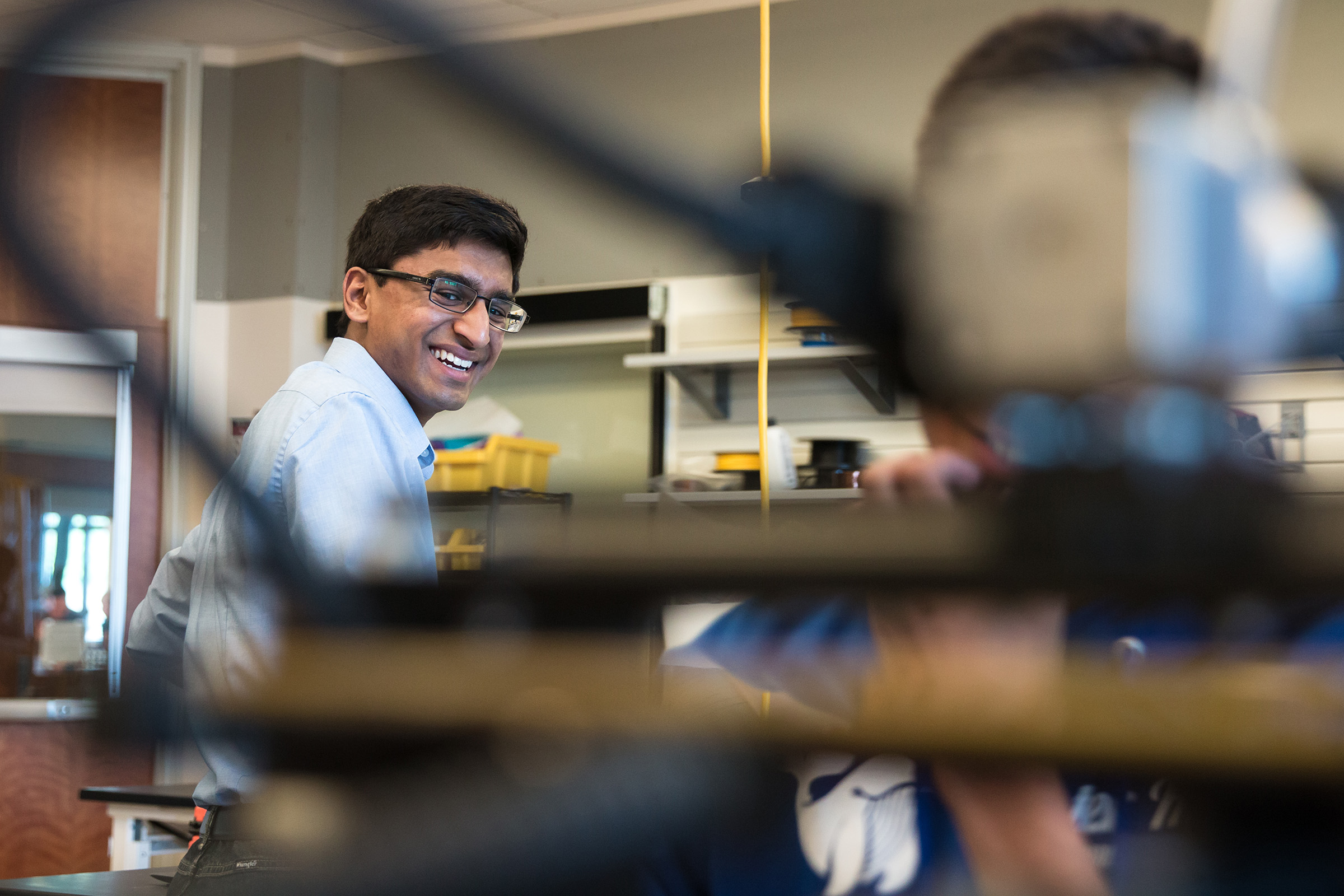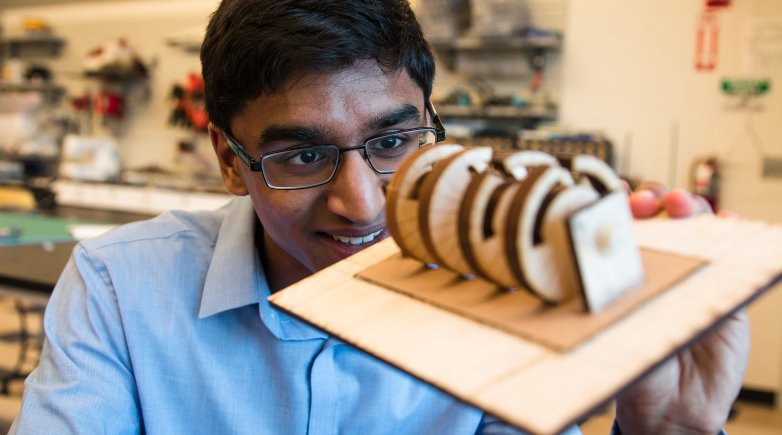Riddle me this
Picking the very impressive brain of Puzzle Hunt founder Vinjai Vale ’18.
Vinjai Vale '18 helped found Exeter's Puzzle Hunt with the goal of pulling together people with diverse interests and talents.
If you were on campus the weekend of May 19, you would have seen Exonians and faculty running around referencing pieces of paper; Academy Building classrooms full of people with signs like “Fish Eater,” “Team Thanos,” and “Naps R’ Us” on the doors; and potentially a guy in a pirate costume running between the rooms. This was the Phillips Exeter Academy Puzzle Hunt, a fun, intense, and intellectually stimulating competition in which teams of six to 10 Exonians compete to solve a series of diverse and diabolical puzzles leading to an object hidden on campus.
Every year, around 25 teams and well over 200 members of our community take part in this unique 48-hour event, founded by the aforementioned pirate, Vinjai Vale '18. Vale and the hunt's organizing team work year-round to put the hunt together. In this year’s Puzzle Hunt, participants solved puzzles to assist a modern-day pirate, Capt. Jacques P. Arrow, in search of the Arrow family heirloom, which was, according to the storyline, hidden by the Phillips family on campus when it was first opened in 1781.
We spoke with Vale about his inspiration for the hunt and what he hopes it adds to the campus community:
Where did you get the idea for the Puzzle Hunt?
The seeds of the hunt were planted back in October 2015, when Richard Chen ’17 and I were reading about steganography, the practice of hiding secret messages in seemingly normal text. This eventually led us to stumble across puzzle hunts, and we were fascinated by their cleverness and excitement. I reached out to some friends to introduce them to the idea of writing a few puzzles for Exeter. In the process, we learned about the MIT Mystery Hunt — the largest and most famous puzzle hunt in the world — and Matthew Hambacher ’17 and I put together an Exeter team to participate in January 2016.
We had the time of our lives. At Mystery Hunt, I realized the unique power of puzzle hunts to bring together diverse people, from artists to history buffs to mathematicians, for a thrilling weekend of teamwork and fun. I returned from MIT determined to share puzzling with the Exeter community, not through a few puzzles on posters as we’d originally thought, but through an ambitious 48-hour event.
That does sound like an ambitious undertaking. How did you pull it off?
Most people thought this was crazy — such scale for a student-run event at Exeter is unprecedented — and it probably was. But soon Matthew, Richard and I had formed a dedicated core team that included Qi Qi ’17, Yannick Yao ’17, and Calvin Luo ’15, who helped write puzzles remotely. Together, the six of us spent well over 1,000 hours during the next few months, meeting in the library or connecting online as we pieced together the 33 puzzles for the first Puzzle Hunt. The hunt would have been impossible without the intense passion and teamwork of the founding team, and we became much closer friends in the process.
“This is the true beauty of the Puzzle Hunt: It brings together very different people who may not ordinarily intersect, for a weekend full of bonding and intense fun.”
To be frank, we weren’t quite sure what the turnout would be. When kickoff rolled around, we were blown away by 29 teams and a packed auditorium of over 250 hunters, including several faculty members. Since then, the hunt has grown more intricate and the puzzle quality has increased as our team has gained experience. In 2017 we introduced a theme and storyline, following Alex the Geologist on his quest to obtain a soda to quench his thirst — a classic from the Exeter math curriculum.
What do some of your puzzles look like?
There is a wide range of difficulty. One of the easier puzzles, from this year’s Pre-Hunt, which we wrote for marketing and plot development, is reproduced below for you to try. The answer is an English word (answer below).

Every year we have a “judge puzzle,” requiring teams to use their wits, resourcefulness and creativity to convince judges from Hunt HQ that they have accumulated a set of quest items that satisfy particular requirements. This year’s judge puzzle, “Assemble the Crew,” involved gathering sailors and special items for a pirate ship, including a musician who writes a song; a fabled cutlass; a captain who recites a rousing speech; and a ship that carries at least 2 kg of cargo. We always love watching the creative solutions that teams come up with. For instance, during last year’s hunt, one team’s Alchemist came up with a word ladder to satisfy the requirement, “turns lead into gold”: LEAD -> LOAD -> GOAD -> GOLD.
In 2018, we included for the first time a physical component to the hunt, in the form of a puzzle box — much like an escape room, but condensed into a single structure. This box was my senior project in the winter. I designed the parts and locking mechanisms with the CAD software in PEA’s new design lab, and did the final assembly with our laser cutter in my spare time in the spring. The final result was a hefty hexagonal box with eight interconnected unlocking components, taking a team of four to six solvers around an hour to complete.
What does it take to launch a successful puzzle hunt?
This type of event requires an extreme level of intellectual diversity. In addition to the puzzles above, our hunts included video puzzles, chamber music puzzles, crossword variants, intense logic puzzles, and several runaround puzzles that follow clues scattered around campus.
Even outside the variety of puzzles, it takes a wide range of skill sets — from marketing to acting to graphic design — to run the hunt. Hunt HQ is highly interdisciplinary, combining people from all backgrounds, and the winning teams are similarly diverse. This is the true beauty of the Puzzle Hunt: It brings together very different people who may not ordinarily intersect for a weekend full of bonding and intense fun.
Editor’s note: When he’s not creating puzzles, this 2018 Regeneron Science Talent Search finalist can be found organizing hackathons, teaching robotics to kids in the community, or studying artificial intelligence in the research lab. Vinjai Vale is heading to Stanford University in September.
 Read how studying the humanities made Vinjai a better scientist.
Read how studying the humanities made Vinjai a better scientist.
Puzzle answer: ISOPODS. The trick is to read along the lines that are shared between two touching shapes among the squares and triangles ("read between the tiles").
